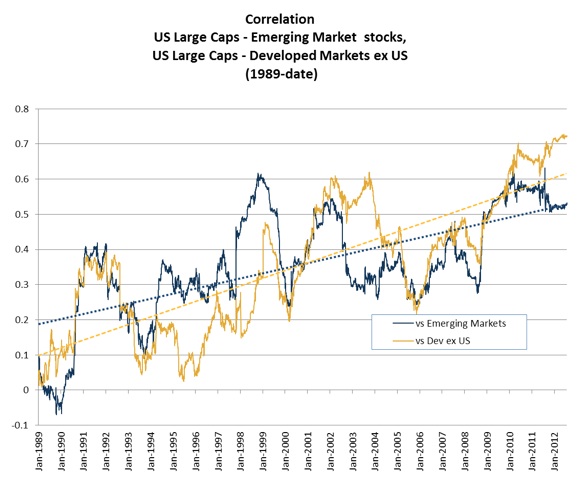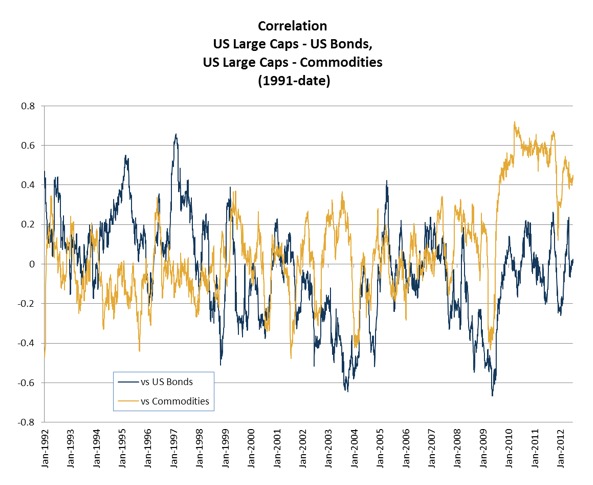 By Raphaël Mennicken CFA, Chief Investment Officer of Covestor
By Raphaël Mennicken CFA, Chief Investment Officer of Covestor
September 5, 2012
Many investors’ portfolios have suffered sharp losses in the past few months following unexpectedly bad news flow regarding – among other things – a “Grexit”, slow global growth, and continued high U.S. unemployment.
Nothing can be done to stop the markets from fluctuating. However, investors can do something to insulate their portfolios from those market movements.
Traditional diversification
The key to this dilemma is the widely discussed concept of diversification. You’ll hear that word many times when talking to an adviser, reading financial websites, or watching financial TV.
Anyone with a certain amount of money to invest is indeed wise to spread it across various asset classes. Many portfolios begin as a collection of blue chip U.S. stocks. From that starting point, the traditional advice has always been to diversify into different regions, sectors, and asset classes.
Why does diversification work?
Diversification has tended to work because, historically speaking, not all asset classes move in the same direction at the same time. For instance, over the long run, large cap U.S. stocks and bonds can be said to be “non-correlated.” Their correlation coefficient is close to 0, meaning that bonds tend to not move together with stocks – up or down.
You could repeat the analysis for Emerging Markets stocks, small caps, and other asset classes. This suggests that you should, in theory, be able to bring your portfolio’s overall risk down by diversifying your assets across multiple asset classes. In finance, this is based on the statistical concepts of correlation, R-squared and beta. Behind those metrics lies a simple truth: different factors drive the performance of different asset classes.
Or rather, they did.
Back in the 1980s, most advisers would have told you to diversify your portfolio among U.S. stocks, Emerging Market stocks, European stocks, bonds, and possibly other asset classes. And they would have been mostly right.
Correlations between asset classes are not constant. In the previous example of U.S. stocks and U.S. bonds, correlation actually fluctuated between -0.7 (diversification would have worked very well) and +0.7 (diversification would have worked, but not as well). But what we find is that in times of crisis, correlations between asset classes move closer to 1 (i.e., all asset classes move in the same direction – down). This effect is temporary, but strong enough to create some unanticipated losses in portfolios that were thought to be immune from such events.
Does diversification still work?
The answer is: “Yes, but…”
The world has changed dramatically, and so have correlations. The chart below shows the correlation between U.S. Large Cap stocks and Emerging Market stocks (blue line), and U.S. Large Caps against Developed Markets (ex-U.S.) stocks (yellow line). Emerging Market stocks and Developed Market stocks are often considered the best diversifiers in a-U.S. based equity portfolio.
Correlation has been steadily rising, all the way to +0.7 (for Emerging Markets) and 0.8 (for Developed Markets) currently.
This is no statistical fluke.
Since 1989, both the world economy and equity markets have become more integrated. Emerging Market countries depend more on the developed world to generate their growth. Emerging market companies are becoming more global, and therefore more exposed to fluctuations in demand from the rest of the world, in the same way developed companies are.
At the same time, capital markets in the emerging countries have grown significantly and have attracted more interest from U.S. institutional investors.
In short, the diversification offered by Developed Markets (ex-U.S.) is still there, but not as strong as before. The same applies to Emerging Markets.
The chart also illustrates that correlation increases in times of crisis (and declines when conditions improve). Witness the increase in 2000-2002/3, and the following decrease, before the so called “credit crunch” started, causing another increase.
The next step in traditional portfolio diversification
Let’s not be too gloomy. There are still ways you can diversify your portfolio.
First, of course, you can turn towards bonds. The chart below shows that the correlation between U.S. Large Caps and U.S. Bonds is relatively low, though it peaked at 0.6. That makes bonds a useful diversifier. The downside of course is that overall returns on bonds tend to be low. Using bonds to diversify your portfolio can therefore lead to an unacceptable trade-off between risk and return.
The conclusion at this stage is that diversification within the equity space is increasingly difficult, and adding bonds can dilute your returns too much.
Luckily, the world of investments is not limited to equities and bonds. So there is hope. But you have to turn to either alternative asset classes (real estate, commodities) or alternative strategies, or both.
A quick glance at the correlation between commodities and Large Cap in the chart above shows that it varies between -0.5 and +0.4, which makes commodities a great diversifier. At present, correlations are significantly higher (which is a sign that we are still in a crisis).
Nevertheless, commodities are one more weapon in your arsenal to diversify your portfolio because, contrary to the comparison among various equity asset classes, there is no fundamental reason why correlations between commodities and equities should trend upwards with time.
So step one is to diversify among asset classes, including alternative asset classes. Nothing new here. Many people do this, and for the right reasons.
The next step, to further improve diversification, is to move away from traditional investment strategies. We’ll be looking at that in an upcoming blog post: Diversification, the future.
Source for charts: Bloomberg data, Covestor analysis





